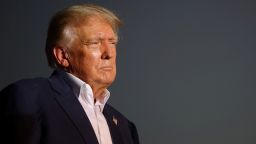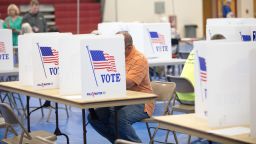Editor’s Note: Julian Zelizer, a CNN political analyst, is a professor of history and public affairs at Princeton University. He is the author and editor of 24 books, including, “The Presidency of Donald J. Trump: A First Historical Assessment.” Follow him on Twitter @julianzelizer. The views expressed in this commentary are his own. View more opinion on CNN.
The House select committee investigating the January 6 Capitol riot broke new ground Thursday with two extremely dramatic moments. One was the extraordinary ending: the unanimous vote to subpoena former President Donald Trump to testify about his role in the riot. “We must seek the testimony under oath of Jan. 6’s central player,” Vice Chairwoman Liz Cheney said.
Cheney explained that the committee is “obligated to seek answers directly from the man who set this all in motion. And every American is entitled to the answers, so we can act now to protect our republic.”
The other key revelation was the never-seen-before footage showing House Speaker Nancy Pelosi, Democratic Sen. Chuck Schumer and other legislative leaders, along with Vice President Mike Pence, scrambling to obtain more police and national guard forces to repel the rioters on Capitol Hill as they realized the threat that was unfolding – not only to their personal safety but also to their ability to carry out their constitutional function of certifying the election.
When they saw little sign of help on the way, they all exploded. “Why don’t you get the President to tell them to leave the Capitol, Mr. Attorney General, in your law enforcement responsibility,” Schumer barked at Acting Attorney General Jeffrey Rosen. The legislative leaders’ frantic efforts to restore peace were in marked contrast to Trump’s failure to take action as he watched the riot unfold from the confines of the West Wing of the White House.
In public hearings during the past four months, the bipartisan panel attempted to reveal the full context of what happened that day and who was responsible.
Unlike the Watergate scandal that brought down President Richard Nixon in 1974, one of the most distinctive elements of Trump’s campaign to overturn the 2020 election is that so much of it happened in broad daylight.
Even before the election took place, Trump never masked his intention to spread baseless allegations of a stolen election if he turned out to be on the losing side. Each time there was a new revelation about something that happened behind the scenes, such as the taped phone call with Georgia’s Republican Secretary of State Brad Raffensperger urging him to “find 11,780 votes,” Trump displayed no shame or remorse. He merely doubled down, insisting that there was no scandal and that he was in the right to do whatever he did.
Trump’s main strategy was rarely to obfuscate. Instead, it was to seek to legitimate his conduct.
Yet the committee managed to fill out the story in very important ways, providing shocking evidence and details as to how the events of those months were even more dangerous than we understood at the time.
During the course of the hearings, the committee brought out five key elements of what happened.
Intentionality: The committee demonstrated that January 6 was not some sort of one-off, unintended day of chaos where events unexpectedly spun out of control. It was premeditated.
The panel examined how intentional the Trump administration had been in attempting to spread doubt about the election results – from testing different theories about challenging the results, to leaning on state officials – like their push in Georgia – to literally change the vote, to mobilizing supporters to intimidate Congress as they certified the Electoral College results.
The plans were hatched before the election took place, and Trump publicly launched his allegations during a press conference on election night. He declared victory as the votes were still being counted. “President Trump,” Cheney explained during Thursday’s meeting, “had a premediated plan to declare the election fraudulent and stolen before Election Day, before he knew the election results.”
As viewers could hear, Steve Bannon said to a group of non-identified associates that the former president would declare victory, which didn’t mean he was victorious, just that he would say he was. “If Biden is winning, Trump is going to do some crazy shit,” Bannon predicted.
When told in subsequent weeks repeatedly by top election and legal advisers, such as then-Attorney General William Barr, that the claims of fraud were “bullshit,” Trump and his inner cabal ignored those warnings and moved forward with reckless abandon.
The committee provided a flurry of testimony from figures such as Alyssa Farah Griffin, who headed White House strategic communications, confirming that Trump knew he lost. He didn’t care. He wanted to retain power.
On the day of the “Stop the Steal” rally, January 6, 2021, Trump knew that the protesters were armed and dangerous but did nothing to stop them. Indeed, he wanted to go to Capitol Hill but was only stopped because a Secret Service agent wouldn’t allow him to do so. The former president even lunged at a Secret Service agent and tried to steer the wheel of the car when he was told he couldn’t go, according to former aide Cassidy Hutchinson.
Orchestration: The campaign to overturn the 2020 election was not a haphazard effort where Trump deployed a chaotic plan, desperate to keep power. Rather, key members of the administration, including the former president and key advisers, deliberately pushed to overcome electoral defeat. “Possession is nine tenths of the law,” Roger Stone said, “We won. F–k you.”
The rhetoric of a stolen election would frame the entire operation, sowing doubt among his supporters about the legitimacy of Biden’s victory and creating a basis for going to court and leaning on state officials. Trump’s team constantly discussed and deliberated over how to achieve their goal.
Trump and his attorneys, such as Rudy Giuliani, probed to see if various state officials would do their bidding. Arizona House Speaker Rusty Bowers, a staunch conservative who backed the administration, was unsettled as Giuliani and Trump pressured him during a phone call in late November 2020 to have the state legislature reconvene and invalidate the results in his state. The president’s lawyer John Eastman, who had written the road map for their attempted election steal, pressured Pence’s aides to have him reject the results.
The committee also revealed evidence of the extensive contact between Trump’s allies, particularly Roger Stone, and militant right-wing extremist groups, such as the Proud Boys and Oath Keepers. There had been extensive intelligence and Secret Service warnings about the serious threat of violence against the Capitol.
Continuum: January 6 was just one piece of a much larger story. Although the panel is called the January 6 committee, it would be more accurate to call it a committee to investigate the campaign to overturn the 2020 election. This reframing is essential to understanding the months between November 2020 and January 2021.
The Trump administration embarked on a systematic “multi-part” plan, as Chairman Bennie Thompson said, to overturn the election. The rally, and the violence, of January 6 were just one piece of a much bigger strategy.
Trump: As Cheney has argued since day one, Trump was at the center of this operation. He “defied the rule of law,” she argued, “This is unacceptable.”
Throughout these events, we have learned, Trump understood exactly what was happening. He was told many times about how he was making claims that were untrue and warned of the dangers he was taking. Even advisers, lawyers such as Barr and conservative media figures such as Sean Hannity who publicly supported him were privately urging him to stop.
To convey his state of mind, committee members made clear that Trump was not “duped” or “irrational,” as Cheney said Thursday. He knew exactly what he was doing. After the Supreme Court rejected a lawsuit backed by the former president in December 2020, Trump, who the Secret Service said was “pissed,” was heard saying he didn’t “want people to know we lost.”
Then on January 6, Trump purposely ignored many warnings of violence. He wanted to lead the troops to Capitol Hill. Democratic Rep. Jamie Raskin of Maryland reminded viewers that he sat passively, watching television, as the attacks against Congress unfolded and as staunch allies pleaded with him to call off the troops. It wasn’t that Trump didn’t act on January 6; it was that he didn’t want to act. “Can you believe this?” Pelosi was heard saying to Thompson that day.
Get our free weekly newsletter
- Sign up for CNN Opinion’s newsletter.
- Join us on Twitter and Facebook
Ongoing Threat: In its pivotal hearing Thursday, the committee wanted to make one thing clear, the danger is not over in 2022. “There remains a clear and present danger to our electoral system and to democratic institutions,” Raskin said, “So, that is something that will come through in our final hearing. This is not ancient history we’re talking about; this is a continuing threat.” That continued threat exists on many levels. The rhetoric of election denialism has taken hold among many of Republican candidates in the 2022 midterm elections.
Republicans who subscribe to this agenda are also running for several key offices, ranging from gubernatorial positions to secretaries of state in key states such as Pennsylvania and Arizona, all of whom will play a key role in overseeing future elections. And, finally, the former president remains the top contender for the Republican nomination in 2024.
During her opening remarks on Thursday, Cheney made this point clear when she asked why Americans should assume that “those institutions won’t falter next time” if the wrong people were in positions of power the next time around. The story of January 6 turned out to be a string of officials, many of whom were Republicans, who refused to go along with the scheme. She reminded the nation that our institutions “only hold when men and women of good faith” make sure that they are strong regardless of the political consequences.
In the end, the committee managed to tell a disturbing story about one of the gravest anti-democratic moments in our nation’s history.
Cheney said the committee is considering making criminal referrals to the Justice Department, but it will be up to prosecutors to decide what, if anything, will result. We will find out if Congress can complete work on reforms, such as the Electoral Count Reform Act of 2022, that renders some of the mechanisms Trump was counting on incapable of doing damage in the future. We will watch as voters determine, in the 2022 midterms and 2024 presidential election, whether to send a clear message to Washington that messing with democracy will not be tolerated. Right now, January 6 has not been a major issue in most of the campaigns.
The committee successfully unpacked the dark days that followed the 2020 election. They have been exposed in clear detail right in front of our eyes. The biggest mystery left is whether as a nation we will close our eyes and simply move forward without demanding accountability, justice and reform.






